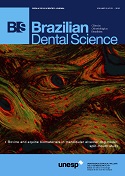Effect of whitening dentifrices on surface roughness of dental nanofiller-based composites. Stereomycroscopy and AFM analysis
DOI:
https://doi.org/10.14295/bds.2016.v19i3.1271Resumo
Objective: the aim of this study was to assess the effects of whitening dentifrices on the surface roughness of three commercial nanofiller-based composite. Material and Methods: two optical analyses were performed: stereomicroscopy and atomic force microscopy (AFM). Disks (8.0 diam. x 2.0 mm thick.) of the nanocomposite Z350 (3M ESPE) and two nano-hybrid composites (EsthetXHD, Dentsply and Premisa, Kerr) were submitted to in vitro brushing (1000 cycles) with three whitening dentifrices (Colgate Luminous White, Oral-B 3D White e Close-Up Diamond Attraction) and a control (Colgate Total12). The results were analyzed by stereomicroscopy and rated according to the following criteria: 0 – no observed roughness, 1 – average roughness, 2 – great roughness. Data was submitted to Kruskall-Wallis non-parametric test followed by Tukey test (p = 0.05). Z350 specimens were assessed by AFM. Results: the surface roughness of composites brushed with whitening dentifrices was statistically higher than the roughness found in specimens brushed with conventional dentifrice. AFM analyses showed that, at a submicrometric scale, there was an increase in the number of peaks and irregularities in specimens brushed with whitening dentifrices. Conclusion: Whitening dentifrices may have an impact on the longevity of dental composites by an increase in its roughness. It is strongly recommended that clinicians guide their patients, warning them about the risks and consequences of their use.
Keywords
Abrasion; Dentifrices; Composites resin; Roughness; Whitening; Abrasive.
Downloads
Downloads
Arquivos adicionais
Publicado
Como Citar
Edição
Seção
Licença
TRANSFERÊNCIA DE DIREITOS AUTORAIS E DECLARAÇÃO DE RESPONSABILIDADE
Toda a propriedade de direitos autorais do artigo "____________________________________________________________________" é transferido do autor(es) para a CIÊNCIA ODONTOLÓGICA BRASILEIRA, no caso do trabalho ser publicado. O artigo não foi publicado em outro lugar e não foi submetido simultaneamente para publicação em outra revista.
Vimos por meio deste, atestar que trabalho é original e não apresenta dados manipulados, fraude ou plágio. Fizemos contribuição científica significativa para o estudo e estamos cientes dos dados apresentados e de acordo com a versão final do artigo. Assumimos total responsabilidade pelos aspectos éticos do estudo.
Este texto deve ser impresso e assinado por todos os autores. A versão digitalizada deverá ser apresentada como arquivo suplementar durante o processo de submissão.




























